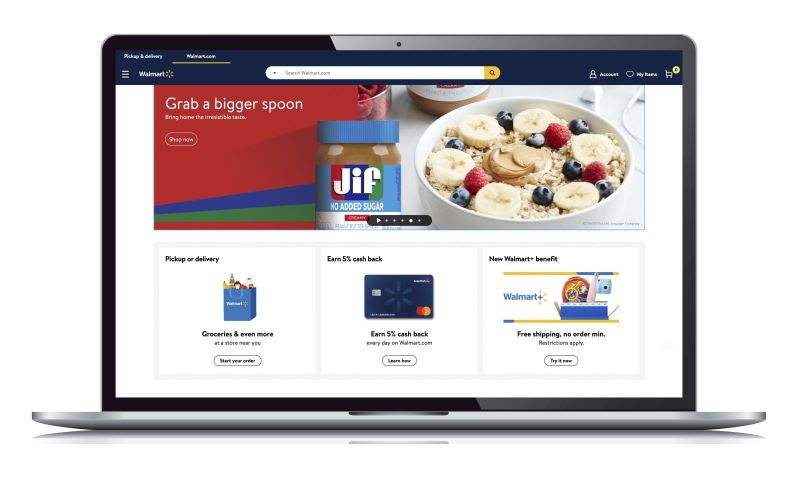Walmart Display Self-Serve Advertising – New Display Auctions Available [Updated]


It’s been a few years since Walmart Media Group rebranded, becoming Walmart Connect. In their rebranding announcement, Walmart shared that the punchier name “reflects the company’s unique ability to accelerate the connection between brands and its 150 million weekly customers.”
With a goal of becoming “one of the top ten advertising platforms in the US,” Walmart Connect said they would maintain focus on 3 top priorities: growing offerings across their digital properties; launching innovative in-store experiences; expanding offsite media opportunities at scale.
As for how well Walmart kept their promise? Let’s just say they were good on their word. In 2022, their ecommerce sales climbed ~11%, coming in at $47.8B.
On the digital front, major advancements have included:
We’ll also dive into a recent change on the Walmart DSS front—Display auctions—and how you can leverage them to realize more efficient ad spend while increasing your visibility.

Walmart DSS is a nimble, self-serve platform that gives advertisers total control over their onsite Walmart display advertising efforts, to include building, activating, managing, optimizing, and measuring campaigns.
The platform delivers the same omnichannel impact as historical, Walmart-managed campaigns, but with greater speed, control, convenience and automation, opening up the door for more brands and sellers of all sizes to take advantage of Walmart’s digital ad inventory.
With no budget minimums, access to Walmart’s robust 1P audiences, and full management control, this Walmart self-serve ad platform offers a streamlined way to build, publish, and optimize your onsite ad efforts at scale, providing a perfect complement to your search campaigns for a full-funnel approach.
Prior to the release of DSS, onsite Display ad opportunities were exclusively managed by the Walmart Connect team. Due to the high minimum spend Walmart-managed Display campaigns command, many smaller and mid-size brands and sellers were priced out of participation.
Even larger brands who could fit Display into their Walmart advertising budget prior to DSS will realize unique advantages working with the self-serve ad platform offers—namely, the ability to have full, on-demand control of your onsite ad efforts. Walmart-managed campaigns offer brands in-flight insights through a performance dashboard, but limited ability to act on those insights. With the introduction of DSS advertising, those levers are now available to pull, making adjustments and optimizations in real-time.
To be certain, Walmart’s post-flight, closed loop reporting is still incredibly valuable, painting a clear, comprehensive picture of your holistic omnichannel impact. This reporting continues to play a major role in informing strategy and execution for future campaigns, complemented by the ability to make in-flight changes without having to wait for ‘next time’ to fully maximize each ad dollar spent.
Walmart DSS campaigns have operated on a guaranteed placement model since their launch, with the recent addition of Walmart Display Auctions expanding options for advertisers. Display auctions allow DSS advertisers to bid on unreserved ad inventory—the ‘leftover’ ads after managed serve and guaranteed campaigns have reserved their inventory.
These ads are typically available at a lower CPM than guaranteed campaigns offer. The downside, naturally, is that a lack of guarantees means your total impressions can vary based on how much ad inventory is available. With that in mind, we recommend setting a foundation with guaranteed display placements, and reserving some budget for the more cost-effective display auction to see how it performs for you.
Targeting options for Walmart Display Auctions, and campaign features, include:
You may notice that ‘Category reach’ is greyed out; this is intentional as macro-contextual targeting is not currently available for Display Auction campaigns. For that level of control, you’ll still rely on guaranteed placements.
Similar to guaranteed Display campaigns, on-demand, in-flight reporting and end-of-campaign reporting is available for Display Auctions. Advertisers choose between setting a daily or lifetime budget—and a minimum and maximum bid (no bid multipliers currently available)—with Walmart automatically pacing accordingly depending on your start and end dates to ensure your budget doesn’t exhaust too quickly. If your in-flight reporting shows opportunity to grow, or you want to narrow the time window, the end date can be adjusted.
Walmart Display Auctions are available with no minimum spend, though it will be necessary to have ~1,000 daily impressions for reporting access. Reporting will typically begin populating 24-48 hours after a campaign or line item launch.
Unique to Display Auction is the Bid Performance Report. Exportable metrics you can find and analyze here include:
“With the release of Display Auctions, Walmart is allowing sellers to tap into additional Onsite Display inventory at a more flexible spend model, allowing you to expand your reach while better controlling costs and performance at scale.”

— Stuart Clay, Director of Marketplace Strategic Services at Tinuiti
Tinuiti has all the expertise, tech and relationships in place to create the right media mix that maximizes performance across Walmart’s digital properties.
Want to learn more about leveraging Walmart Display Self-Serve’s streamlined platform features to scale your onsite ad efforts? Reach out today to chat with an expert!
